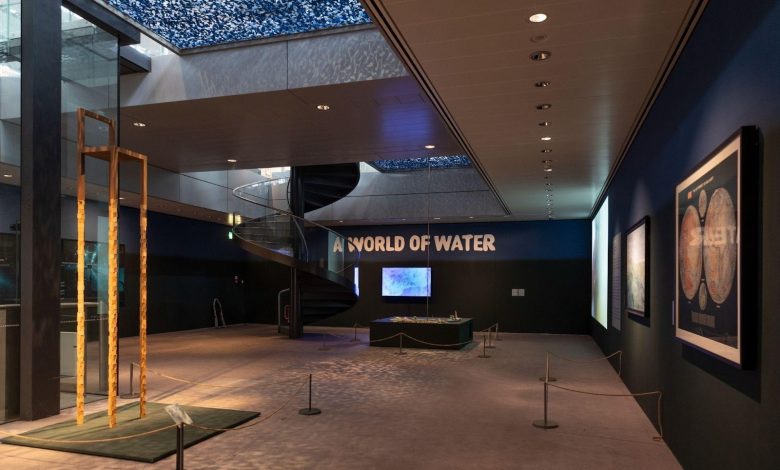Review: A World of Water & Darwin in Paradise Camp @ Sainsbury Centre, Norwich

As I stepped into the Sainsbury Centre in Norwich, I was met with a thought-provoking exhibition titled “A World of Water”. The show is part of the “Can the seas survive us?” season, which prompts us to reflect on our relationship with the ocean and its future. One of the first works that caught my attention was Boris Maas’ “The Urge to Sit Dry”, a chair with legs raised to keep us above the predicted 65-centimeter rise in sea levels by 2100. The towering chair is a striking visual representation of the devastating impact of climate change on coastal cities and low-lying islands. Opposite this work is an imagined picture of the Earth if all oceans and seas were to dry up, leaving our planet resembling Mars more than the blue marble we call home.
As I explored the exhibition, I was struck by the diversity of artworks and historical artifacts on display. The show takes us on a journey through history, with ancient maps of the Anglian coast and Dutch paintings that highlight the close proximity between the UK and the Netherlands. The inclusion of Dutch artists adds a unique perspective to the exhibition, and I was particularly drawn to the works of Claire Cansick, whose vast seascapes transport you to the open water. The wave-like paintings are timeless, yet the presence of wind turbines on the horizon serves as a reminder of humanity’s footprint on the ocean. Julian Charriere’s images of the “midnight zone”, an area being considered for deep-sea mining, also caught my attention, as they reveal the teeming life that exists in this seemingly desolate region.
The exhibition features a range of artists, from well-known names like Maggi Hambling and Olafur Eliasson to lesser-known talents who, in many cases, overshadow their more famous counterparts. Eva Rothchild’s striking red-and-white seawall, which cuts across the largest gallery, is a notable exception, as it dominates the space and draws attention to the accumulation of human-made and natural detritus. The show’s curatorship is intentional in its ability to encourage discussion and raise important questions about our relationship with the ocean, rather than providing straightforward answers. This approach aligns with the gallery’s multi-year programming intent to foster dialogue on broad topics that impact us all.
Running concurrently with “A World of Water” is Yuki Kihara’s “Darwin in Paradise Camp” exhibition, which offers a distinct and refreshing perspective. The show is a fun and engaging exploration of Western views of the Pacific Islands, examining how artists like Paul Gauguin and scientists like Charles Darwin have shaped our understanding of these regions. The exhibition features a tropical open hut, films with drag actors, biological specimens, and a painting by Gauguin, all of which work together to challenge our assumptions and redress historical inaccuracies. While “Darwin in Paradise Camp” feels like a separate entity from “A World of Water”, the two exhibitions complement each other beautifully, inviting visitors to consider the complexities of our relationship with the seas and the ways in which our actions impact the ocean and its inhabitants.
As I reflected on the two exhibitions, I was struck by the importance of considering the seas and their role in our lives. The “Can the seas survive us?” season at the Sainsbury Centre is a timely and thought-provoking initiative that encourages us to think critically about our actions and their consequences. The pay-if-and-what-you-can basis for entrance to the museum makes the exhibitions accessible to a wide range of visitors, and I would highly recommend taking the opportunity to experience these shows. Whether or not the seas can survive us is a question that remains to be answered, but one thing is certain – these exhibitions will leave you with a deeper appreciation for the ocean and a renewed sense of responsibility to protect it.
As I left the Sainsbury Centre, I couldn’t help but feel a sense of wonder and awe at the complexity and beauty of the ocean. The “A World of Water” and “Darwin in Paradise Camp” exhibitions are a must-see for anyone interested in exploring the intricacies of our relationship with the seas. With the “Can the seas survive us?” season running until October 26th, there is ample time to visit and experience these thought-provoking shows. Whether you are an art enthusiast, a scientist, or simply someone who cares about the future of our planet, these exhibitions are sure to leave a lasting impression and prompt important discussions about the role of the ocean in our lives. By engaging with these shows, we can begin to form our own views on the critical question of whether the seas can survive us, and what we can do to ensure their survival for generations to come.








